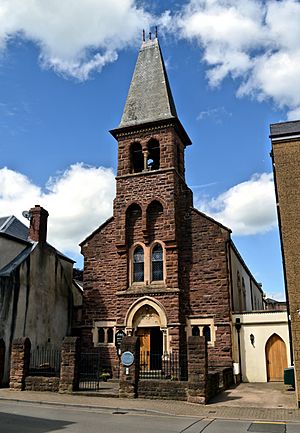St Mary's Roman Catholic Church, Monmouth facts for kids
Quick facts for kids St Mary's Roman Catholic Church |
|
|---|---|

St Mary's Catholic Church
|
|
| 51°48′44.3″N 2°42′47.1″W / 51.812306°N 2.713083°W | |
| Location | Monmouth, Monmouthshire |
| Country | Wales |
| Denomination | Roman Catholic |
| Architecture | |
| Architect(s) | including Benjamin Bucknall |
| Years built | 1778 |
St Mary's Roman Catholic Church is located on St Mary's Street in the heart of Monmouth, Wales. This church holds a special place in history. It was the very first public Catholic church allowed to open in Wales after the Reformation.
The church building shows a mix of styles. It started as a late Georgian church. Later, a famous architect named Benjamin Bucknall added more parts in the Victorian style. St Mary's Church has been recognized as a Grade II listed building since August 15, 1974. It is also one of 24 important buildings you can see on the Monmouth Heritage Trail.
Contents
A Look at St Mary's Church History
For a long time after the 1500s, Monmouth was a place where many people secretly practiced the Catholic faith. By 1773, Monmouth had one of the highest numbers of Catholics in all of England and Wales.
Laws Change for Catholics
In 1778, laws against Catholics, known as the Penal Laws, became less strict. This change happened because of the Papists Act. People in Monmouth asked the local leaders if they could build a "Public Catholick Chapel."
One of the people who asked was Michael Watkins. He owned the Robin Hood Inn. Before the church was built, Catholic services, called Mass, were held secretly in an upstairs room at his inn.
Building the First Church
After much discussion, permission was given to build St Mary's Church. This was three years before a similar church was allowed in Chepstow. However, there was a local rule that said Catholic and Nonconformist buildings had to be hidden.
This meant the church could not look like a church from the outside. Its entrance was not allowed to face the main road. Also, Catholic worshippers had to arrive one at a time to avoid drawing attention. The first church building was set back from the road, hidden behind a row of small houses.
Victorian Additions and Changes
Later, when rules against Catholics became even easier, the small houses in front of the church were taken down. This happened during a big rebuilding project led by Benjamin Bucknall.
The oldest part of the church is the east end, built in 1793. This area now forms the sanctuary and sacristy. You can see a beautiful stained glass window on the left of the sanctuary that has a Georgian Gothic design.
In 1829, Catholics gained even more freedom with Catholic Emancipation. The chapel was then made bigger in 1837. This addition included the chancel, which was about half the length of the main part of the church today.
In 1871, Benjamin Bucknall carried out a major redesign. He added the tall tower and a detailed front made of Old Red Sandstone. The church now has a unique look with its "double bellcote" and a very steep slate roof. Inside, the font (a basin used for baptisms) has a carving of the serpent from the Garden of Eden wrapped around its base.
Important People in the Church's History
From 1835 to 1851, a priest named Thomas Burgess served at St Mary's. He later became the Bishop of Clifton, a very important leader in the Catholic Church.
Special Features Inside the Church
St Mary's Church has many interesting things to see. One of the most important connections is to Saint John Kemble. He was a missionary who worked in Monmouthshire and Herefordshire.
Saint John Kemble's Story
Saint John Kemble was killed for his faith in Hereford on August 22, 1679. He is buried nearby in Welsh Newton. The Welsh Marches region, where Monmouth is located, was a place where the old Catholic faith continued for a long time after the Reformation.
Many large houses in the area secretly offered safe places for Catholic services. Priests who were discovered could face severe punishments. The St Mary's parish still organizes a special trip, called a pilgrimage, to Saint John Kemble's tomb. This trip happens on the Sunday closest to the date of his martyrdom.
Historic Items and Refurbishments
The church also has an altar dedicated to Saint John Kemble. This altar was used for Mass during the times when Catholics were persecuted. It was made of two benches that could be separated to hide its true purpose. These historic parts of the church were updated and repaired in 2009 and 2010.
Other treasures in the church include a processional cross from the 1300s. There is also a red chasuble (a special robe worn by priests) with embroidery, which dates back to about 1502. The church also has a hinged cross, possibly from Spain, made in the 1600s.
See also
 In Spanish: Iglesia de Santa María (Monmouth) para niños
In Spanish: Iglesia de Santa María (Monmouth) para niños

